How to Draw a Circle in Trinket
Are you excited for a fun Python tutorial for kids? Nosotros promise then. Because today we're going to walk you through edifice your first animation in Python - a stick figure!
Python is a great linguistic communication for young coders to acquire. Information technology is designed to be human friendly, allowing students to develop coding skills without some of the frustrations of more cumbersome languages. Python also has a huge number of use cases: information scientific discipline, software, art, Artificial Intelligence, and more.
You need no Python experience to piece of work through this tutorial. Just nosotros recommend you accept some experience with Scratch coding or some other language. If you'd like to jump right into learning even more than, join our free Python coding class led live past an proficient, and designed by professionals from Google and MIT.

Getting started with the Python tutorial for kids
To showtime this project, you'll be using a template in Trinket.io. Trinket.io is an interactive evolution environment, or IDE for curt. We utilize IDEs to lawmaking in Python (and other languages), and Trinket.io is especially useful in that nosotros tin use it to easily share code online.
If y'all would like to relieve your piece of work, y'all'll need a Trinket.io account. Once you've created one, yous tin save by clicking "remix." All your work volition be saved in your Trinket.io library.
Take a await at your IDE. You'll detect that the lines are numbered on the left side of the screen. This is especially useful when communicating where you are in your code - this tutorial will utilise line numbers in the reference lawmaking we show you lot. Additionally, detect that the starter lawmaking, displayed on the left side of the screen, has lots of different colors of text. This is a dainty feature of IDEs that helps to visually prove what different pieces of your code do.
Finally, if you lot make whatsoever changes in your code, they won't show up on the right side of your screen (your output console) until you run your code. Y'all run your lawmaking by clicking the "play" button.

Step ane. Choose a background
Our first pace is to cull a background for our project. To assistance you, nosotros've called four unlike options, shown on lines 5, half-dozen, 7, and 8.

Y'all'll detect that these backgrounds are currently green, and take a # sign in front of them. This is chosen a comment. Comments are lines of code that the computer volition ignore when it runs your code. To choose a background, yous need to delete a # before the line with the background yous like:

Now, the figurer will read it!
Footstep 2: Choose a character
When you run your code (press the play sign!) you volition now see your groundwork. Y'all will also encounter a turtle. The turtle is your drawing "pen" and volition be the device we utilise to draw. We are not stuck with a turtle, notwithstanding, and you can choose a different character, or what you might also know as a "sprite" from Scratch.
To exercise this, we're going to look at Trinket.io's paradigm library. To find the library, click on the image push button.

Find a character you similar! Once y'all've called, highlight the entire proper name (including the file extension, .png) and re-create information technology.
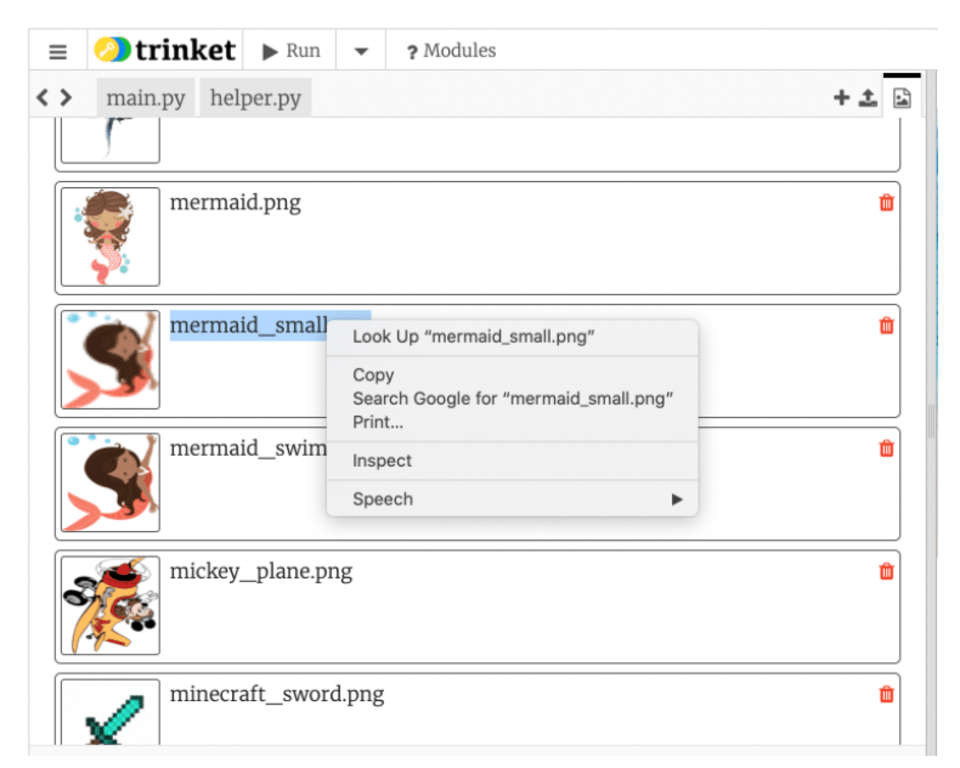
Click on main.py to become back to your code window. Then, paste the file name between the two sets of quotation marks on line 12. If you run your code now, you'll see your chosen character appear!

Step three. Commencement drawing
Nosotros're all ready to start cartoon our stick figure! To get-go, we will describe the torso. To draw in Python, nosotros utilise functions from the Turtle library, which has lots of tools that let you to be as artistic and innovative in your art every bit you would like.
Two of the about important cartoon functions we'll learn today are pendown() and penup(). Call:
- pendown() when you want to put your virtual pen on the sail and leave a mark, and
- penup() when yous want to move around the canvas without cartoon.
Cartoon in Python involves moving in straight lines and turning. Y'all'll accomplish these moves using the following commands:
- frontwards(100)
- astern(200)
- right(90)
- left(180)
The commands forward(100) and backward(200) move your character forwards or backward the number of steps listed in between the parentheses - so in this case, 100 steps forrard, 200 steps backward. You lot can change these numbers to whatever you desire.
The commands right(90) and left(180) turn your character the number of degrees listed in between the parentheses - so in this instance, 90 degrees to the right, or 180 degrees to the left. You tin change these numbers likewise.
Draw the trunk
Nosotros'll use a combination of all these functions to depict the body. Try typing the following lawmaking into your IDE and run your code to see what happens!
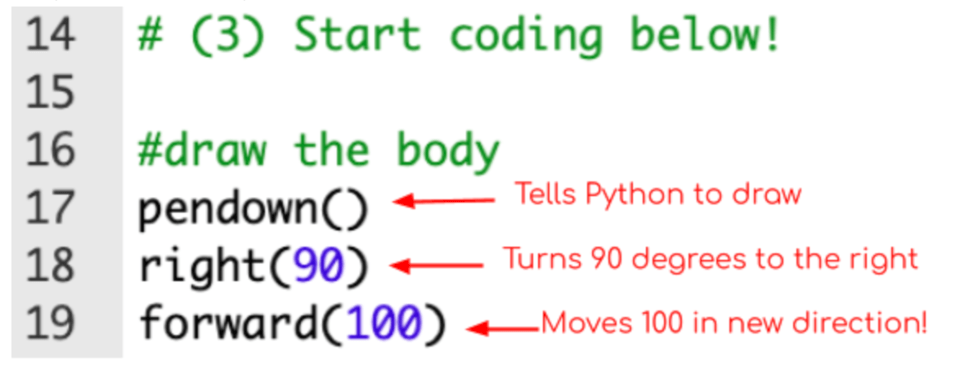
Draw the legs
Let's requite our stick figure some legs. We'll employ the aforementioned commands we've learned already, but change up the angles and the distances. Notice that after we draw the legs, we're going to move upward to the top of the body. What line makes this happen?
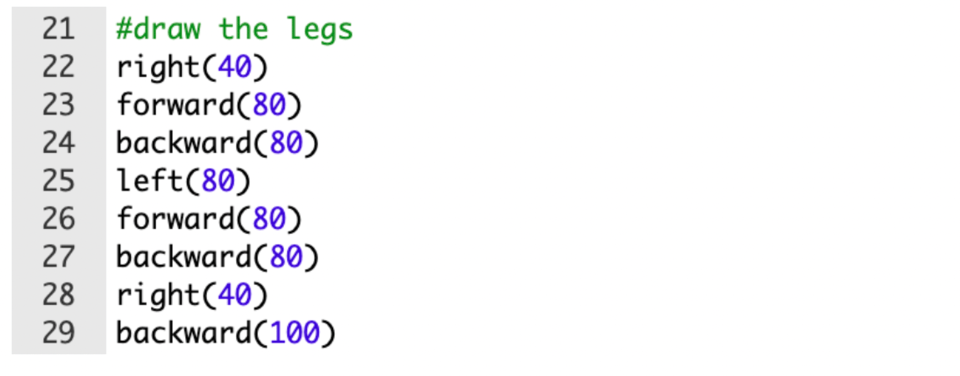
Draw the arms
We can reuse the code we've used for the legs to describe the arms. Merely permit'due south switch it upwardly a bit and change the color of our pen. Right at present, we're using the default color, black. To alter the color to something else, nosotros'll use the control colour("green"). Trinket.io has a lot of colour options.
Notice that nosotros put "green" in quotation marks.

Describe the head
To draw a head, we're going to innovate a new function: circle(fifty). This office lets usa draw a circle of radius l - or whatever radius you lot want. Before you describe your circle, try changing the color to something new.

Depict a grin
Our last step today is to give our stick figure a smile. We can do this using circumvolve once more - all we have to do is add another input. circle() can take 2 inputs (besides chosen arguments) - the radius, and the extent, or the number of degrees around the circle that you want to movement.
Examine line 56 in the code beneath to see how we add together a 2nd argument, 180, which instructs Python to depict 180 degrees of a circle.
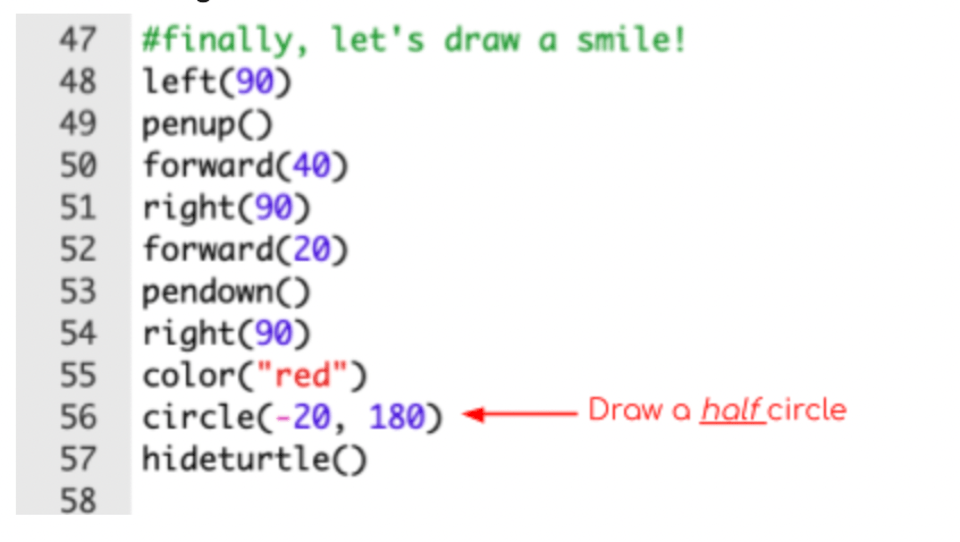
Note that on line 57, we call the command hideturtle(). This command hides our character then it doesn't sit on acme of my drawing.
Your final drawing should look something like this:
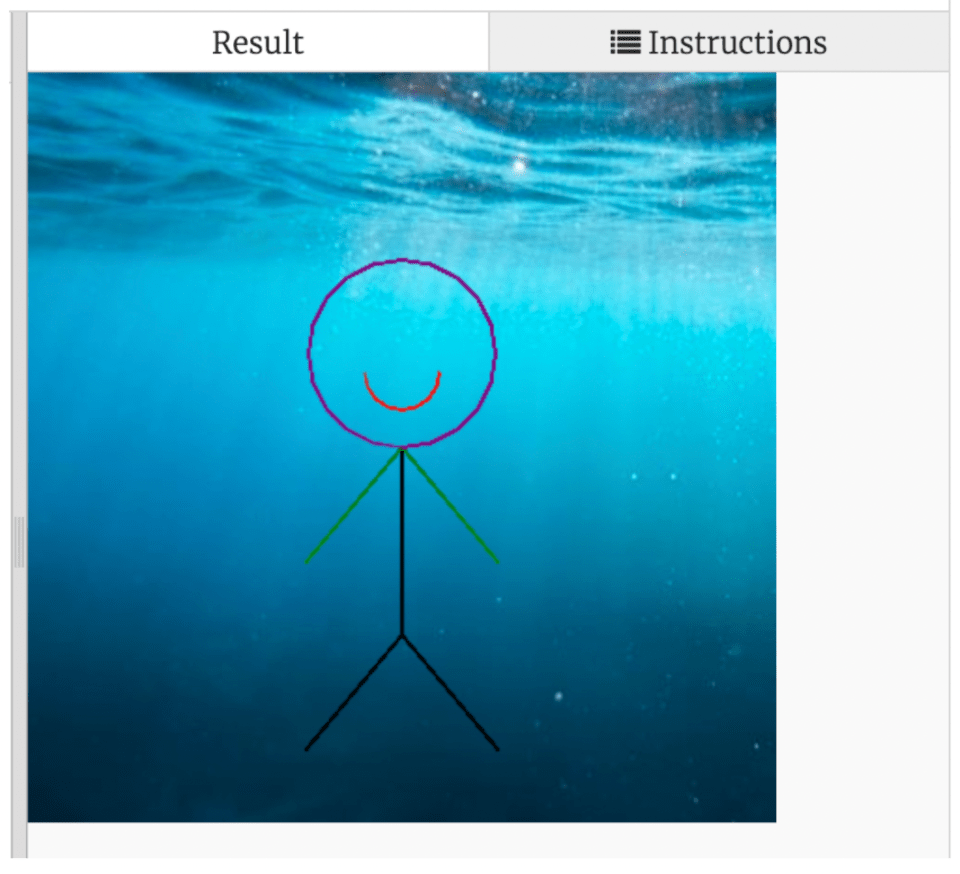
Step 4: Challenges
Congratulations! You've just fatigued your outset animation in Python!
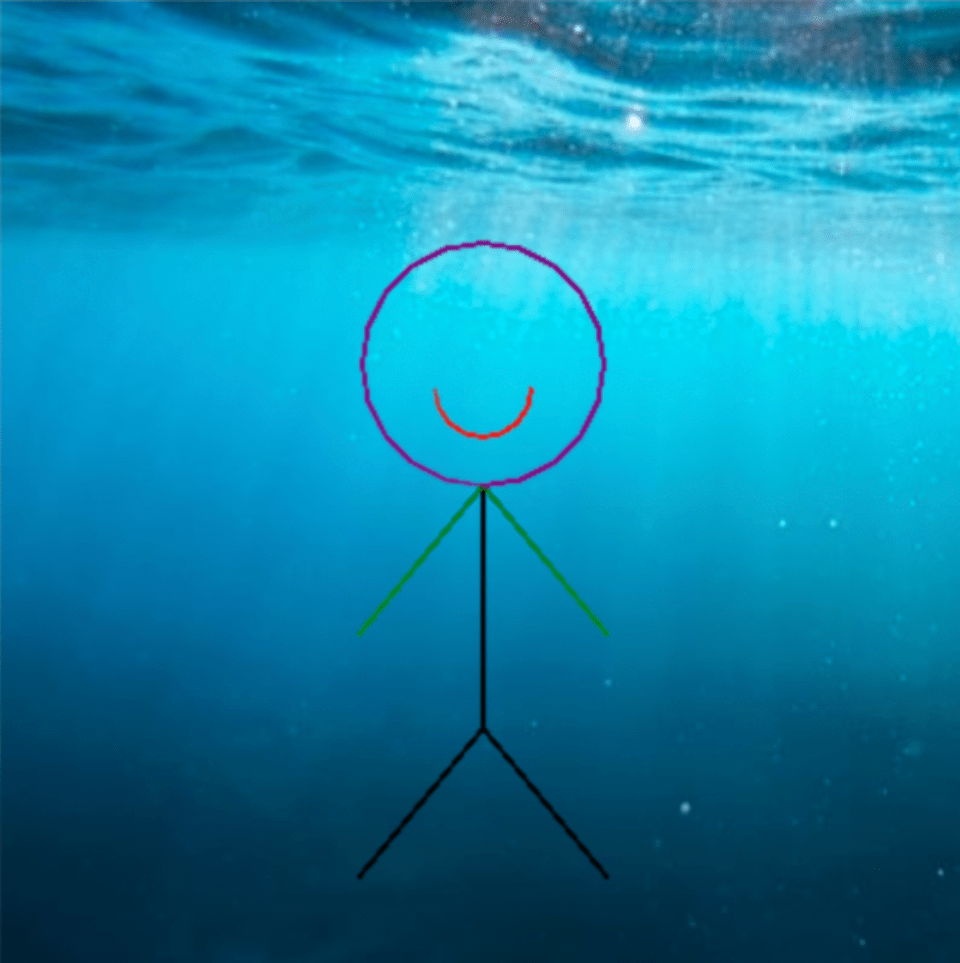
There are other commands you tin can use to enhance your drawing toolkit, but you've learned many of the primal cartoon tools for Python coding today. Some things you can add to your stick figure:
- Optics
- Endeavour typing dot(30) and seeing what it does :)
- Hair
- Habiliment, a lid, or some shoes
What else can you remember of to add together? What exercise you lot desire to create?
Next steps afterwards your Python tutorial for kids
Desire to create new animations, games, quizzes, and more? Keep learning Python with Create & Learn and our accolade-winning coding for kids plan. We offer 4 levels of Python for kids, Python camps, and a costless Python grade. Bring together along to build more animations, and learn the information science fundamentals through project-driven instruction.

Written by Sarah Rappaport, who graduated from Northwestern University with undergraduate and graduate degrees in technology and music. She's now working on a masters in data with Georgia Institute of Engineering. She taught math and information science with Teach for America for two years, and at present works as a Systems Engineer.
Source: https://www.create-learn.us/blog/getting-started-with-python-programming-for-kids-build-your-first-animation/
0 Response to "How to Draw a Circle in Trinket"
Post a Comment